If you are looking for a fun and unique way to decorate your home, you should consider making a rag rug! Rag rugs are easy to make and can add a touch of personality to any room.
This blog post will discuss what rag rugs are, how to make them, and the benefits of using them in your home décor.
Related: 9 Chemical-Free Spring Cleaning Hacks + Recipes
Rag Rug Tutorial | How To Make a Rug
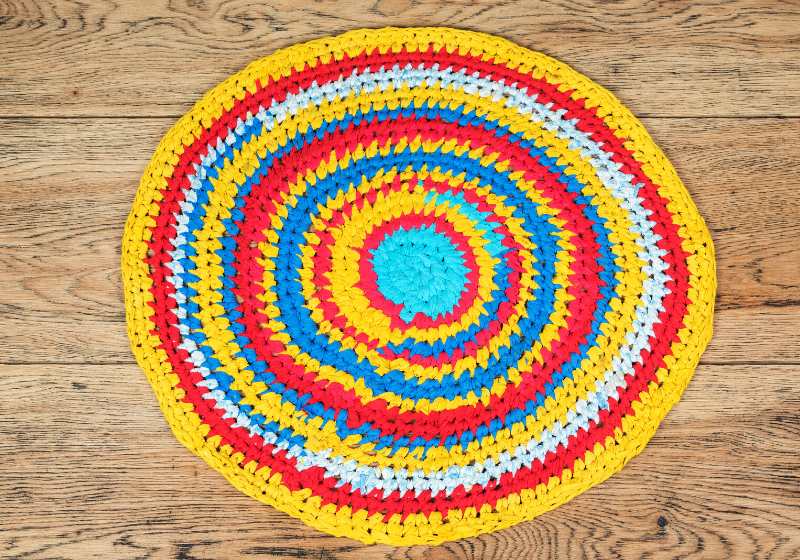
Click here to jump to the infographic.
Do you have many old clothes or fabrics and don't know what to do? Why not make a rag rug! Rag rugs are a great way to recycle old materials, and they are really easy to make. So gather up your old clothes and get ready to create something new!
What Is a Rag Rug
What is a rag rug? Rag rugs are fabric scraps, so they are a great way to use up old clothes and fabrics that you might not want anymore. Rag rugs are a popular DIY project, and you can make them in any shape or size.
Make a rag rug out of your leftover fabric scraps or old tarnished clothes and rags! It's a great and fun way to recycle and repurpose. You'll fall in love with this old homesteading tradition.
How To Make Old-fashioned Rag Rugs
Step 1: Tear the Strips
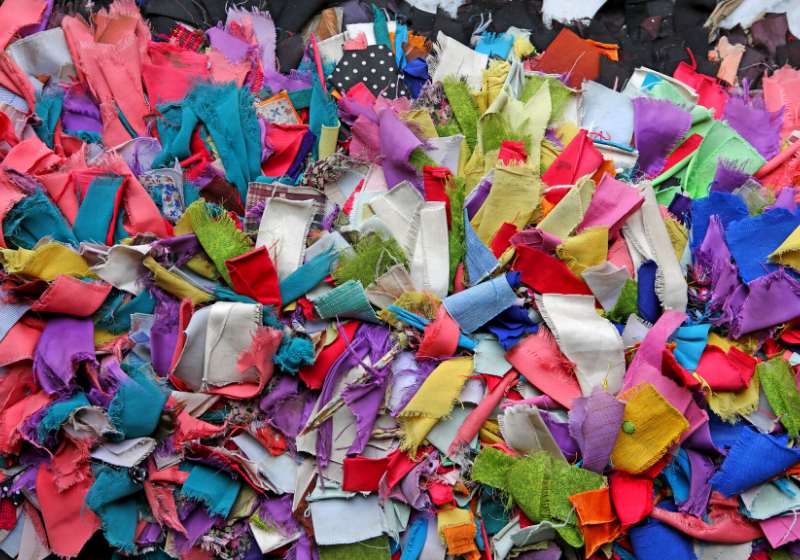
Gather old textiles. Easily tear the strips by snipping a few inches into the fabric with scissors and then rip it across.
Step 2: Sew the Strips
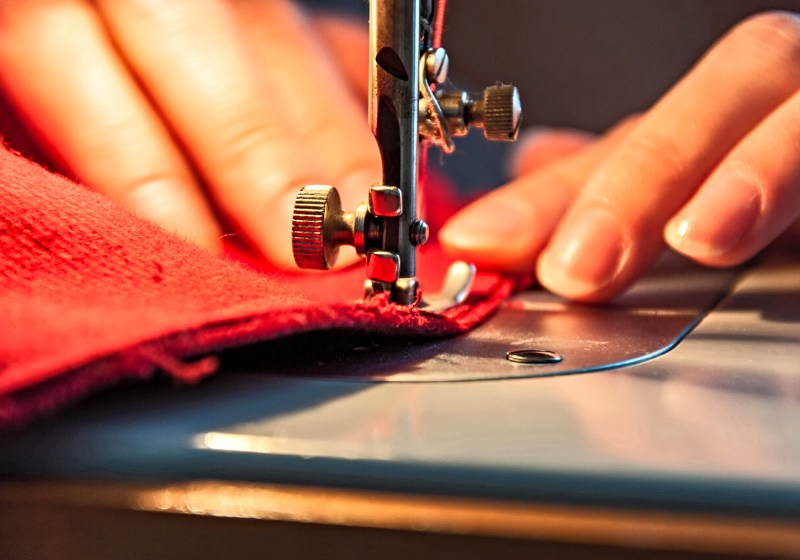
Sew the strips end to end with a single straight stitch, choosing the next piece by whim or art.
Step 3: Roll the Cloth Into Balls
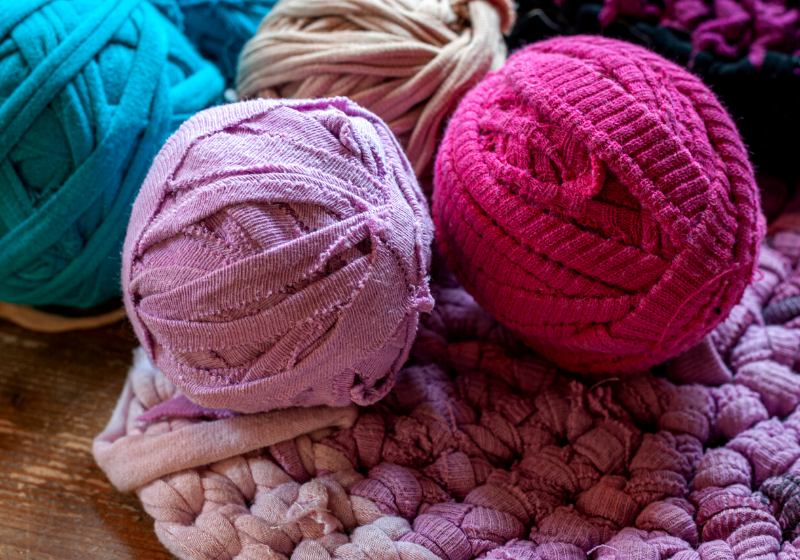
Roll it up around and around your fingers. Once it's big enough to hold its shape, you can wrap it around and hold it.
Step 4: Make the Rug
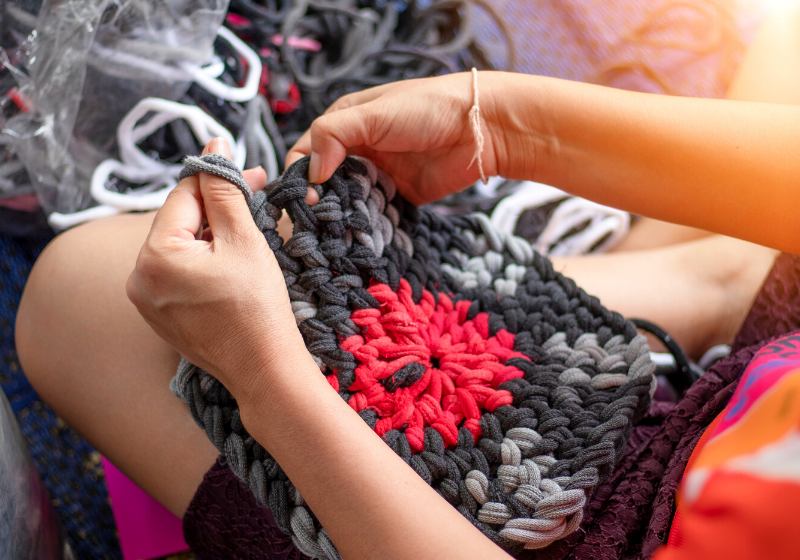
After making the rag rug yarn, you can weave the rug together in several ways. First, weave it on a loom. Then, knit it or crochet it! There are no rules!
How To Make a Braided Rug
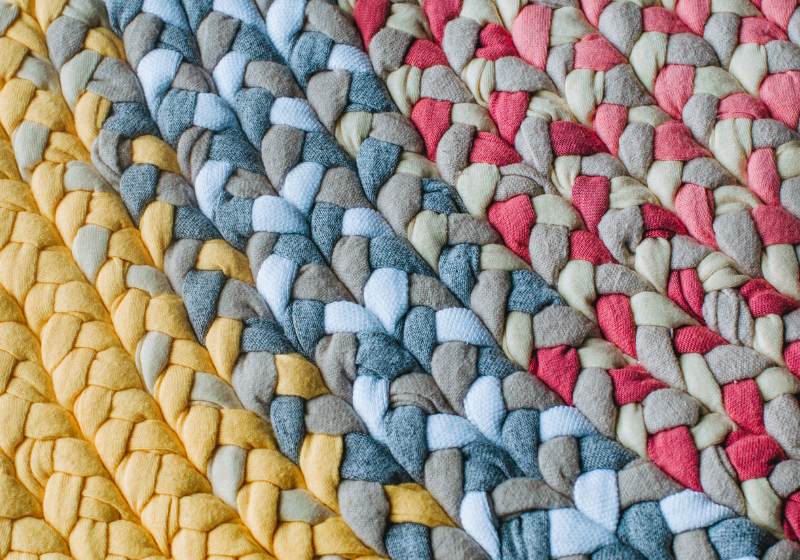
- Tear the fabric scraps into long strips.
- Braid the strips together into one long braid.
- Sew the wide braid into a large circle using a heavy-duty needle and a straight stitch. Be careful to keep the rug flat as you go wider and wider. Finally, lock in the tail with a zigzag stitch.
The Story Behind My Journey
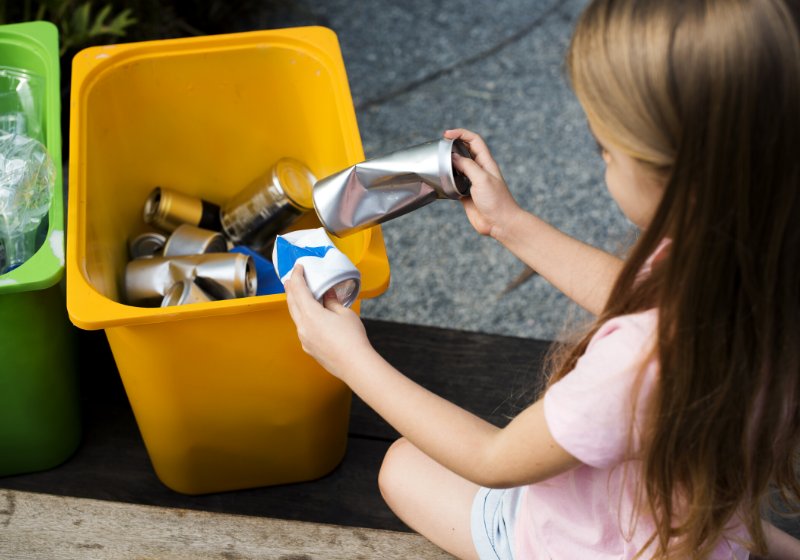
It is highly practical for everyone to recycle. It's just a smarter way of living, not to mention the dwindling landfill space and non-renewable resources such as fossil fuels like gas that we use daily in vehicles.
However, recycling is not a new concept. I remember practicing recycling in my home when I was a kid, too, only I was not aware that it was known as recycling. I always flattened tin cans and bundled newspapers at home during my childhood. Then, every Saturday, my mom would put on a pot of soup from the week's leftovers as if routine. Nothing ever went to waste in our home.
My parents are phenomenal. They survived the Great Depression and knew how to stretch a buck. My mom never disposed of anything if she could find another use for it.
Why Recycling Is My Favorite

I would dare not toss it away when a towel wore out or a sock was widowed. So instead, it became a rag for cleaning.
Undershirts with holes make good dust rags, and thin old bed linens can be torn and used for many things. For example, we converted them into paint rags or tie-ups for our tomato plants and kite tails.
My favorite memory of recycling as a child involved the rag bag.
There was one summer in kindergarten when I outgrew my favorite gray and yellow plaid dress. So my mother and I tore it into strips for the rugs.
- We removed its hem and some of its seams.
- Then we pulled out the gathers at the waist.
- We removed the buttons and saved them in the button box; we did not dispose of them.
- My mom started to make little snips, about two inches apart along the edge of the fabric.
- And then we tore it.
When my mom tore my dress up, she placed the strips of fabric from my dress into a big brown paper bag.
It was jumbled together with blue flowered apron strips, brown and white striped shirt strips, pink blouse strips, and red flannel nightgown strips. The result amazed me. My old dress was still good for something.
But this was not the end of the project. There were some mysterious pieces of cloth that I'd never seen before in the pile of clothes that my mom tore up earlier that day.
She stored all of the rag bags in the attic. I can still remember opening the door at the foot of the creaky wooden attic stairs where we battled our way through the cobwebs with a rolled newspaper, wielded as swords to enter safely.
The attic was as hot as a sauna as it always was every summer. The sun slanted through the dirty window, filled with dancing dust mites.
After shaking and blowing layers of dust from the rag bags, my mom opened the bag and immersed her hands, sifting her fingers through the cloth strips.
She would collect the rag cloths in bunches, by evidence of the quantity and array of colors in her hand. I can envision her doing this with the smell of cotton, dye, and soap that surrounded her.
My mother would smirk in accomplishment after they passed her examination, and we brought them all downstairs where the real magic could begin.
Sewing the Strips
I watched her sew the strips from end to end, choosing the next piece by whim or art. Sometimes the color trails shaded from dark to light, and sometimes they abruptly changed from yellow to black to green to red.
You had to sew one strip to the next with a single straight stitch. It was very simple and very mesmerizing. The long, exotic fabric snakes coiled on the floor behind the sewing machine as she worked.
Some years later, the old black and gold Singer treadle she owned was eventually converted into an electric portable.
But, I cannot imagine my mom sewing in any other way but with her right foot resting on the treadle and the left cocked so that only the toes could brush each other.
She would hit the flywheel with her right hand to start the needle driving up and down. She set a rhythm with her feet while working and would often start and stop as she added in new scraps of color. She did not break a sweat.
Rolling the Cloth Strips Into Balls
The next step in the project was rolling the cloth strips into balls. My father and I got to help with this one. Again, pieces of my dress showed up in each of the balls.
When finished, my mom packed the product into May Company Department Store bags that had handles and carried them to Mrs. Rodecker, who owned the store.
Mrs. Rodecker was a widow who supported herself by doing needlework for neighbors and also weaved rag rugs.
The last I saw of my gray and yellow plaid kindergarten dress was part of three different cloth rugs and other scraps of our lives.
The remnants were woven with bulky white threads and fringed at the ends. Each rug was a kaleidoscope of memories that could last for years for an individual.
Don't forget to download, save, or share this handy infographic for reference:

You could buy a rag rug for just a few bucks at the store. But it won't be the same. You may even opt for a cotton rag rug or even a braided rag rug, but that may cost you more.
If you want a budget-friendly rag rug, I recommend recycling your fabrics and making your own rather than purchasing one. If you must purchase one, get it from a sustainable source and ensure the fabric is from repurposed cloth strips.
Have you ever made a traditional rag rug before? Please share your experience with us in the comments section below!

My Finnish Grandmother weaved rag rugs on the huge loom made by her husband, my Grandfather. They outlasted anything from a store, and were washable. The loom is long gone, in a barn fire. But the rugs are still on floors, by the door or in front of the kitchen sink. They are reminiscent of the Old Days, when frugality was a necessity, and recycling hadn’t yet been named. My Grandparents had a really hard life, but they knew how to ‘make do’, and they laughed & loved easier than most folks do now.
how do you, finish de rug? Grace
How do you finish the rug
This is not a real article. It is the kind of click bait you normally find with titles like ‘You Won’t Believe…’ Or ‘This Old Trick’. Shameful.
I think this gentleman, truly has not lived yet. and has come from where everything was handed to him.
I may be a bit older, so that could be the problem. For my Mom, Aunt, and grandmother, all made these
rag rugs thru the years. Sir, Sorry that your generation, has missed this treasured art/craft. It is real, and we all
appreciate those of our ancestors who were more frugal than many in today’s standards.
Well said! So much history, and love, went into what they made out of goods that had fullfilled their lifecycle and recycled into a new household item. Memories flood my mind when i see the ’70’s or older vintage fabrics that were once winter garments, grandma’s house coats, aprons, flannel night gowns that were gifts from Santa that we found under our tree on Christmas morning, and so many more. I’ve been wanting to make braided rugs myself; feeling inspired now! Thanks!
Kristin
This is the comment of someone ignorant or malicious. THAT is what is truly shameful, Random Guy. Shame on you.
I have successfully made rag rugs from those nasty plastic grocery bags. Bags twisted into ropes and knotted together to get to the ball stage. Be aware some of the bags will biodegrade in the Sun otherwise they work well outside or where wet.
My mother saved rags and cut 1″ wide strips that were sewed together as pictured. Balls of a workable size. When she had enough to start she’d sit and single crochet around and around adding just enough stitches to keep it laying flat. She used a very large crochet hook. When it was big enough for our living room she tucked in the last end and stitched it by hand to keep it from unraveling.
My dads aunt had a 4 harness loom threaded with a heavy white cotton twine. She wove the rags on that look. I loved watching her.
Dad made a 3′ x 5′, 2×4 frame for me. We drove finish nails in the 2 shorter end bars 1/2″ apart. I wrapped my rag strips end to end on those nails until I reached the last nail where I tied the end to a single nail on the long bar just like where I started. Then I used a homemade shuttle. A long slender 1/2″ thick board a foot long. It was 1″ wide with a deep notch in the center if each end. It had been sanded down till the edges were thin and all of it smooth as glass. Rags were wrapped around the length of it in those notches. The shuttle was taken through the rags in the frame in an under over repeating sequence across the width of the frame. The the next row was done the same way except it went over where the previous row had gone under. A long 3/4″ dowel then went in the exact same pattern as the rag row and pulled the row straight and tight against the previous rows. I did the every two or three rows to keep it straight. At the end I tied the end I was weaving to the end that had been tied onto the nail. I then cut the tails an even 3″ long. I tied the starting row the same way. Then I took a length or rag and tied matching tails at the remains corners. Tails weren’t necessary as the ends could just as easily been tucked in and hand sewn to make sure they stayed in place. Very simple and my clothing made my bedside rug. I was 9 years old so anyone could do it.
My next rag rug was made on the sewing machine. I used a washed and dried old potato sack but any sturdy material would so. I then sewed 6″x 18″ strips in ruffled rows 1″ apart, till the base was covered. I sewed the strips one row of stitches down the muddle of each strip so the had double ruffles 3″ long. I didn’t hem the edges as it was old polyester materials that didn’t ravel. The long edges could be zigzaged or cut with pinking sheares to stop raveling. I didn’t join the strips, just kept adding strips, and lengths weren’t precise. I sewed around the outside then again another row 1″ inside from the last sewn row till I reached the center. It made a pretty, fluffy rug I used in my bathroom. It matched the colors of the room. Since them.
I’ve made more as this is the easiest of all and easily washed in my washing machine. I like one in front of my chair. My mother used one on her lap after she was confined to a wheelchair. I made it on a sturdy triple thickness of flannel I’d sewn together from old shirts with some rows of stitching in both directions to keep it laying flat while I sewed on the ruffles. It was soft and warm. My daughter took one made with old tee shirts in many colors for her preschool nap pad.
Why couldn’t this article tell us a how? Because a neighbor actually made the rugs and she didn’t know how they were done. I couldn’t make the video play.
I have also cut plastic grocery bags in 2″ strips and single crocheted them for rugs In front of the washing machine and In front of the sink. They can be washed in the shower or outside with a hose but will take a long time to get dry. Sun will start degrading them or I might have some one for the front porch. I’m thinking a ruffled rug, in denim from old jeans, would look nice with my 2 rocking chairs on the front porch.
Clergylady…
I don’t know Mrs Roedbecker, so using this article, no rag rugs will ever be made. Only balls of ripped stupis of cloth. That was the no brainer part of the project. This should be retitled. It’s s cute story about childhood memories. But no rag rugs are made from that.
Um, actually they are…I make them all the time this way. If I called give you an eye roll right now I would.
How do you do it I want to take clothes from my daughter who just passed and make small ones for her daughter
My mom crocheted those balls into oval rugs that seemed to last forever. Thanks for reminding me of her.
I grew up like you, recycling without knowing that was what we were doing. My mom would recycle almost everything.
But I do remember sitting outside with my grandmother and great-gramdother tearing strips of fabric and rolling it up, Instead of sewing the strips of fabric she would knot the ends together then crochet the rugs. I still have one of her rag rugs that was made back in the 70’s (she died in 1981 at age 94). Now I am doing the same, continuing this tradition.
I am disappointed that a pattern and instructions for braiding and sewing or crocheting weren’t included or linked to this article. You basically gave us part 1 and we need part 2 to make a rug.
Not everything in life gets handed to you. A few clicks on Google or Pinterest should find you what you are looking for
Where is the tutorial?
By the time I closed all the pop-up notifications and navigated my way past the writer’s life story, I found I was no longer interested in making my own rug. I’ll just pick up something affordable at Target.
The picture shows a rug made by using a locker hook and canvas, your pictures in the article show a woven rag rug????????
Can you do a tutorial? Thanks
Watch the video!!
My Nanny made rag rugs. Sure wish I had one now. My mom threw them all out (along with my original Barbies I might add). Loved helping her roll the fabric and watch her crochet them.
This is not a tutorial. For the prissy people intoning “Not everything in life is handed to you,” this is true, because clearly no one handed the author of this “tutorial” a dictionary. A tutorial teaches you HOW TO DO SOMETHING. This did not teach one how to make a rag rug.
But it did share some wonderful memories! I’m sure youtube has tutorials, but I certainly enjoyed reading the reminder of bygone time. My first chance to use a sewing machine was sewing those torn strips together.
It helps keep the rug flat if the thickness (weight) of the fabric is consistent throughout, all light cotton or all pant/ skirt weight or wool, etc. That way you won’t have lumps that you can trip on. You’d have to make a lot of rugs to pay for a broken hip😢.
I don’t sew my ends, I put a slit in the each end of each strip to loop the next strip through. Then even a very, very young child can “help”.
I’m a braider so I just overlap my ends and let the tension hold it in place. Any fiddly bits sticking out get gently tucked back in lol I’m lazy
If your fabric is not consistent in weight, for example work jeans and worn denim shirts, cut a few test strips. The heavier work jeans fabric requires narrow strips, maybe 1″. The threadbare shirt, maybe 1 3/4″. There’s always a way and the web is full of tutorials!
First the picture was of a crocheted rug and then they are telling how to braid three strips together. It is not correct. there are no instructions. I have done dozens of round and oval rugs with a #13 (M) hook. and taught many to do it.
There are instructions somewhere but not in this article. Sorry.
How it’s made is an overview of HOW ITS MADE. If you want a tutorial, best to look for one labelled as a tutorial. This covered exactly what it promised and if you’ve crocheted so many and taught more, why do you need a tutorial and instructions? Also the poster states that the strips were taken to be made into rugs, implying that neither she nor her mother was proficient in crochet. Sorry.
I have a sweet friend Mary Wilson who made my granddaughter a rug like her GGma made. It is awesome! She did the slots at each end. Pieces of fabric and a needle and thread can make amazingly beautiful things
My mother has always made rag rugs. I remember her making a new one for our bedrooms after we would change wall paper or paint. She is now 93 years young and at the beginning of the pandemic she wanted to have a project so she started a rug. In the past year she has made over a dozen of them for family members and friends. I decided to give it a try and have made three rugs as well. It is easy, fun and relaxing. I like to hit up the sales at the local thrift shops to buy men’s shirts or sheets to strip up and use. For just over $10 I got enough strips to make 3-4 rugs!
Me and my 15′ braid, and growing, loves this. Technically, “How to make” doesn’t require a tutorial and isn’t misleading. The first style can be crocheted or loomed. If crocheting or looming is your craft, you already know how to do this and the article is nudge to recycle and not purchase new to do the same thing. If you can’t crochet or loom, it’s not practical to turn this into a massive tutorial. You are better off learning to crochet granny squares and rounds before you learn to crochet a rug. If you came to make a rug, the braided style is perfectly well covered here. A “How to…” Article doesn’t need step by step instructions. Ever seen HOW ITS MADE? Kinda like that. You get the overview and the order of steps but the details aren’t covered.
Absolutly loved your story. It has got me reminiscing about when I was a child and watching my mum making clothes from patterns. My Grandmother told me about how her and her Aunties would save all kinds of fabric and have multiple uses too. My sister makes rag rugs so I’m getting her to teach me how. Thank you for your insight :0)
Well I know how to make a rag rug from reading this article and I’m going to, and will find it wonderfully soothing to see my grown up children clothes that I have saved put to good use.
You can’t stop dogs from barking, but there are some odd comments here. I suspect them of trawling, some, and bitter viciousness, others.
HowI miss the old days. I enjoyed this article very much.
Thank you, I am hoping to make a rag rug, braided style, like my great grandma used to make. We had them still in my childhood, but they were very big and my hands don’t work so well. I wanted to know if I could join the braided fabric on the sewing machine, rather than by hand. I’ll give it a go from these instructions 😊
Not sure why there were more complaints, this is a lost art and we can only gather so much info. I thought the braided part was lovely and simple.
Thank you
Would have been nice for some more information to explain.
Thanks for sharing your memories.
I would also love to try this – but with wool. I imagine that almost anything could work – ratty old sweater, for example. With your technique, I imagine you could use almost anything…
My mom always made rag rugs, using old clothes, sheets etc..After she made the balls of materials, she used a single crochet stitch, and a large wooden crochet needle..I’ve often thought I’d like to made a denim rug, but I think it would be too heavy when wet, for my washing machine..My mom had an old wringer washer, that could handle it, and then the wringer, would squeeze out the excess water..Just rinsing with a hose would take forever to dry, and be stinky, by that time..My mom remade everything..nothing wasted..The older generations were amazing..I always loved the idea of making do, with what’s available..
66 years old, remember my mother making these but didn’t remember how she did it so I looked for information on the Internet. Read all of these comments and the guy toward the beginning of the comments is an idiot. I’ve done a lot of different things in my life to include repairing army tents using a long arm industrial singer. I believe I can make my rug from the information given along with my experience in life. For younger people with less experience or knowledge just look around on the Internet, you will find what you need. “I’ll just go buy a cheap one at target is a chicken way out. Anything worth having is worth waiting, WORKING for.
This is a great tutorial on how to make a rag rug! I love the different ideas you’ve included.
My mother made a 9 x 12 rug. She used wool made from old coats and things that she saved and found the Goodwill. I believe she made her narrower strips because it was heavier and then she breaded it. I remember when it got to big for her lap she would be sitting on the floor when she was sewing it together. It lasted forever. It was beautiful.